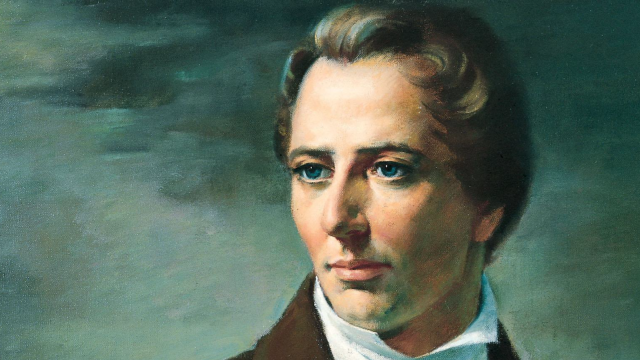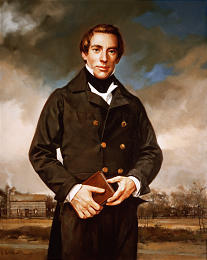The article titled “In Our Lovely Deseret: What pioneers wrote of their impressions of the Prophet Joseph Smith” by Susan Evans McCloud appeared in the 29 September 2016 online edition of Deseret News in the Faith section.
Those who were privileged to meet the Prophet Joseph Smith in the flesh were universal in their responses to the experience.
President Lorenzo Snow, who joined The Church of Jesus Christ of Latter-day Saints as a young man in Kirtland, Ohio, was just one witness.
“I heard the Prophet (Joseph Smith) discourse upon the grandest of subjects,” he said, which was recorded in “Remembering Joseph,” by Mark L. McConkie. “At times he was filled with the Holy Ghost, speaking as with the voice of an archangel, and filled with the power of God; his whole person shone and his face was lightened until it appeared as the whiteness of the driven snow.”
George Spilsbury was baptized in England and later became a member of the Nauvoo Legion, seeming to expand on this same theme.
“In his preaching, I have heard him (Joseph) quote scriptures in Greek, Latin, Hebrew, and German,” he said (see “Personal Glimpses of the Prophet Joseph Smith,” by Hyrum L. Andrus and Helen Mae Andrus). “He was a great man — a statesman-philosopher, also a revealer of many things in philosophy and astronomy.”
Bathsheba W. Smith, a convert from West Virginia, married the Prophet’s cousin, George A. Smith, and became the fourth general president of the Relief Society.
She left a lively description of Joseph. “The Prophet was a handsome man — splendid looking, a large man, tall and fair,” she wrote (see “They Knew the Prophet,” compiled by Hyrum L. Andrus and Helen Mae Andrus). “He had a nice complexion. His eyes were blue, and his hair a golden brown, and very pretty.
“My first impressions were that he was an extraordinary man, a man of great penetration; was different from any other man I ever saw; had the most heavenly countenance; was genial, affable and kind; and looked the soul of honor and integrity.”
Elizabeth B. Pratt crossed the ocean from England as a young girl, arriving in Nauvoo in November 1841.
“When I was first introduced to the Prophet, he held my hand and said, ‘God bless you.’ There was such an influence with his words I wondered how anyone could doubt his being a prophet,” she wrote in an article in 1890 in “The Young Women’s Journal” that was published in “Personal Glimpses of the Prophet Joseph Smith.”
Perhaps Joseph knew this young convert would need that word of blessing, for Elizabeth wrote, “My father only stayed nine weeks in the church. He apostatized and moved away to Warsaw with the family. I stayed on the ship Zion which has brought me safely thus far on my journey.”
She added, “We would meet to worship on the Sabbath in a large bowery where he (Joseph) sometimes addressed the assembly for two to three hours. The Saints were rapt in profound attention by the words of inspiration that fell from his lips.”
Every time Joseph Smith spoke — to individuals or to the Saints as a whole — he taught something. Every act of his, every word, was a blessing to others — for so hundreds of the people who knew him testified.
“He was visited constantly by angels, he had vision after vision that he might comprehend the great and holy calling that God had bestowed upon him. In this respect, he stands unique. Think of what he passed through! Think of his afflictions, and think of his dauntless character!” said George Q. Cannon, who knew Joseph Smith in Nauvoo and was later the first counselor in the First Presidency to President John Taylor, President Wilford Woodruff, and President Snow (see “Personal Glimpses of the Prophet Joseph Smith”). “He was filled with integrity to God, with such integrity as was not known among men. He was like an angel of God among them.”
“The Prophet’s voice was like the thunders of heaven, yet his language was meek and his instructions edified much,” wrote Joseph Lee Robinson in “The Journal of Joseph Lee Robinson.” “There was a power and majesty that attended his words that we never beheld in any man before.”
People heard him talk to God in prayer. They received blessings under his hand. They heard him preach and prophesy. They saw him teach, inspire and support women. They saw him play tenderly with their children, they saw him direct and defend their youth; upon many occasions, they saw him weep. And with the power of his own humility and goodness, many times the Saints saw the Prophet forgive.
After years of faithful service and the blessings of a personal relationship with the Prophet, Parley P. Pratt fell victim to the raging spirit of apostasy that swept through Kirtland following the dedication of the temple there.
He records in “Autobiography of Parley P. Pratt”: “It seemed as if the very powers of darkness which war against the Saints were let loose upon me.”
When Parley criticized the Prophet to John Taylor — whom he had helped teach the gospel — his friend’s reply had the power to awaken his senses. “If the work was true six months ago, it is true today,” said President Taylor in “John Taylor,” by Francis M. Gibbon. “If Joseph Smith was then a prophet, he is now a prophet.”
“I went to brother Joseph Smith in tears, and, with a broken heart and contrite spirit,” Pratt recorded. “He frankly forgave me — prayed for me — and blessed me.”
Gilbert Belnap, a convert from Canada, who later served as a bishop in Utah, wrote this of Joseph Smith: “While I was standing before his penetrating gaze, he seemed to read the very recesses of my heart — I gazed with wonder at his person and listened with delight to the sound of his voice. My very destiny seemed to be interwoven with his” (see “Autobiography of Gilbert Belnap”).
Today, as ever, the gospel will go forward. As George Q. Cannon testified: “It is indestructible, for it is the work of God. And knowing that it is the eternal work of God, we know that Joseph Smith, who established it, was a Prophet holy and pure” (see “Life of Joseph Smith the Prophet”).
About Guest Author
Twitter •



 Watch a video about the restoration of the gospel on lds.org
Watch a video about the restoration of the gospel on lds.org